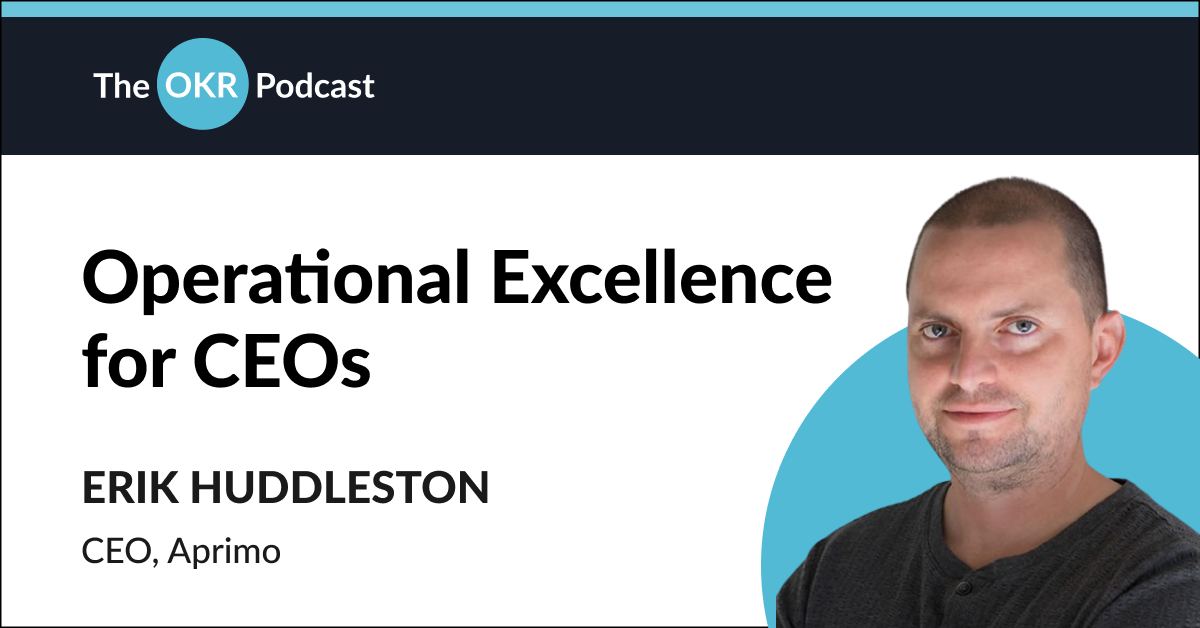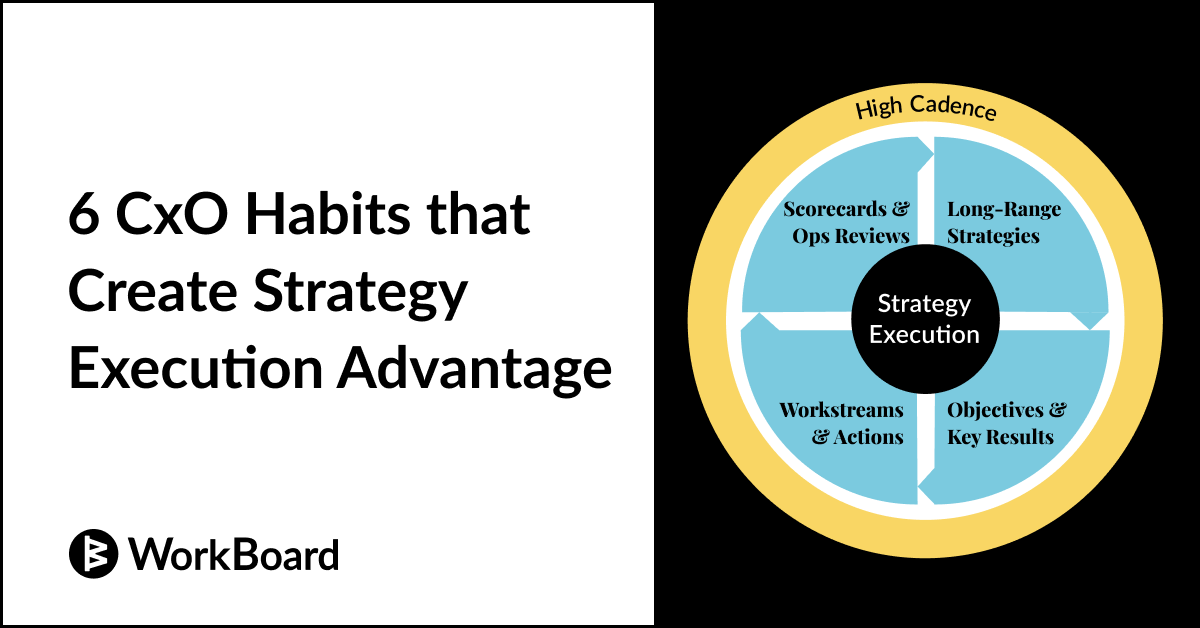Data-Driven Strategy Execution
The only reason to implement OKRs is to improve strategy execution and drive peak organizational performance — to increase the predictability and probability that you achieve your long-range strategic ambition by concentrating attention on the most important outcomes. In my work with both company leaders and the folks leading OKR implementations, I find there are 2 sources of confusion that get in the way of peak performance.
The first is your operating rhythm
The cycle of strategy refresh, quarterly business reviews, monthly ops reviews, weekly staff and 1on1 meetings. It exists solely to ensure resources are marshaled to executing your strategy and ensuring you remove roadblocks faster. The focus in the quarterly, monthly and weekly meetings should be on those things that will cause you to achieve the EOQ and EOY outcomes you need. This is how you create or increase certainty. (If that’s not what your OKRs are about, you are doing them wrong.)
For many senior leaders, the purpose of the operating rhythm has gotten lost in habitual meetings. They’ve become administrivia management rather than strategy accelerant and execution assurance. There is little or no data trail from conversation to conversation, no golden thread of strategy that connects the annual/quarterly/weekly/monthly dialogue or threads accountability between them. There is no source of truth on what that strategy even is, what part of it you’re executing this quarter, or how well you’re executing on it despite the many lagging measures and KPIs. So you manage the news of the day in your weekly meetings and the project line items in the monthly meeting, only to wonder whether you’re really making any progress on the strategy after the 100 page deck in the quarterly business review.
OKRs don’t belong outside of your operating rhythm, they belong at the center. They provide the golden thread of strategy and radical clarity on what to focus on now — this week and this quarter — to achieve your strategic ambitions. They are the focus, they’re not competing for focus.
Revisit the agendas in your cadence meetings and rewire them to serve their true purpose.
The second is the fallacy that “the win” is the process of discussing our best outcomes and dreams each quarter.
I hear this often — it’s the process of setting OKRs, not the platform for driving them that is most important. The discussion is certainly necessary and cathartic but it’s far from sufficient, and there are countless failed OKR implementations to prove it.
Discussing our dreams is 1% of achieving them, focusing our attention daily and weekly, quickly resolving cross-org resource constraints, and removing roadblocks as fast as possible are the other 99%. In other words, it’s what you do after you set OKRs and how fast you do it that lead to peak performance. We’ve forgotten Sun Tzu’s millennials-old observation from the timeless The Art of War: “Strategy without execution is the slowest route to victory.”
After you set OKRs, the platform is where you see how capacity is really allocated, what needs focus, and the risks that need resolution.
Aligning your capacity to execute with your strategy
OKRs help you concentrate resources on executing your strategy, and the first payback of a platform is getting the transparency to know where you have unfocused or misaligned resources. In a 30k person company, this will no doubt be hundreds of teams – thousands of people – that you can shift to focusing on executing your strategy faster. It’s literally gaining on ramped headcount to execute at no cost.
This benefit is lost entirely when companies rotate to “process purity”, moving slowly to perfect the writing of OKRs at each level before they roll out their strategy execution platform as if simply writing strategic priorities drove achievement. These rollouts take over a year, giving companies 5-10% alignment while they have little or no transparency on 90-95% of their organizational capacity to execute.
An alternative — deploying a strategy execution platform to all teams and having them start by writing imperfect OKRs that reflect their current understanding of the strategic priorities (GenAI now makes their imperfect OKRs better than even practiced teams) — gives the organization an instant inventory of where their capacity to execute is really allocated, where strategy is poorly understood, and where misalignment is most egregious. This approach is data-driven resource allocation and alignment that detects misallocations in 1-2 quarters and get the insights to intelligently optimize the same year, while the other approach never optimizes resources allocated to its strategy.
"43% of Senior Leadership have deprioritized outcomes for their teams."
— Ana Cervantes, Senior Manager, Strategy Execution, Avery Dennison, at Accelerate 2024
"WorkBoard is the only thing in the universe that can give you a snapshot of your alignment across the company. And we'll routinely see companies that have 5% alignment across cross-functional teams."
— Joel Neeb, Chief Transformation and Business Operations Officer, 8x8, at Accelerate 2024
Pervasive focus and accountability for strategy execution
The next payback is how quickly you can identify risks and issues and resolve them which is a power factor in peak performance — do you wait all quarter, or did you spot it and address it as it trended out in week 3? The company that spotted the issue and resolved it in week 3 always wins.
And these things only happen with the data and insights the platform provides. Where do we need more focus? Where are the cross-org pinch points? Where are the roadblocks on product that will compromise our ability to deliver revenue or market share? What risks two levels down need attention right now or we will fall short this quarter? These insights are what a strategy execution platform provides proactively.
Clarity decreases and decision volume increases as you move down the org chart
Some senior leaders miss the “insight” forest for the “data entry” trees, creating bureaucracy rather than a strategy accelerant. When you ask, “how much time do people need to spend updating this?” you miss the big picture and the potential to create a culture of accountability.
When we ask people to “update their KRs” we are setting ourselves back rather than moving forward; what we really want is transparency so we can all make better decisions this week and we want people to take accountability for the outcomes for which they are responsible.
A strategy execution platform is how you drive pervasive accountability and attention to strategy execution. When Joe looks at the results he agreed were most important on Monday mornings and takes ownership of his progress toward them, he also sees exactly where to focus his efforts this week before it too flies by. The platform tells him automatically which are at risk and worthy of higher effort this week to make up the gap. In less than 5 minutes every Monday, Joe now has the insight to make an active choice on where his time goes for the rest of the week informed by your strategic priorities. Use the platform to drive alignment, attention and accountability, and peak organizational performance will follow.
Process doesn’t drive peak performance, insights and actions do
15 years ago, companies debated whether salesforce automation was a good idea. It was contentious: Should we require a systematic approach, should everyone have to do the same thing in the same system or is sales an art form and each artist manages his own paint supply? 10 years ago, organizations decided to take a single process, single system of record approach to individual goals as well – everyone uses the same cycle and system because the organization wants to make both individual and aggregate decisions based on structured data.
Today, no one can imagine running a company or a sales organization without the ability to measure pipeline building and progression to create predictability and visibility on quarter and annual sales. A strategy execution system does exactly that for all the results that comprise a company’s strategy. And no one can imagine telling employees to write goals anywhere they like – a scrap of paper, a Word doc, an asana task – leaving each team manager to assemble them, make opaque decisions, and give HR the piece parts. Instead, organizations focus on robust implementations of CRM and HCM systems for the data.
It’s a brutal irony that when it comes to the organization’s strategic objectives (arguably the single most important thing in the business) and the team objectives that drive those company outcomes, we’ve somehow convinced ourselves each team should do its own thing, the data isn’t important to insights or actions, and there is no operating impact of gathering up all the bits and pieces to get the full picture.
If you ask me, it's not the OKR process at all. The win is a great strategy execution platform implementation that provides data-driven insights to drive peak performance within and across teams and for the enterprise as a whole.








